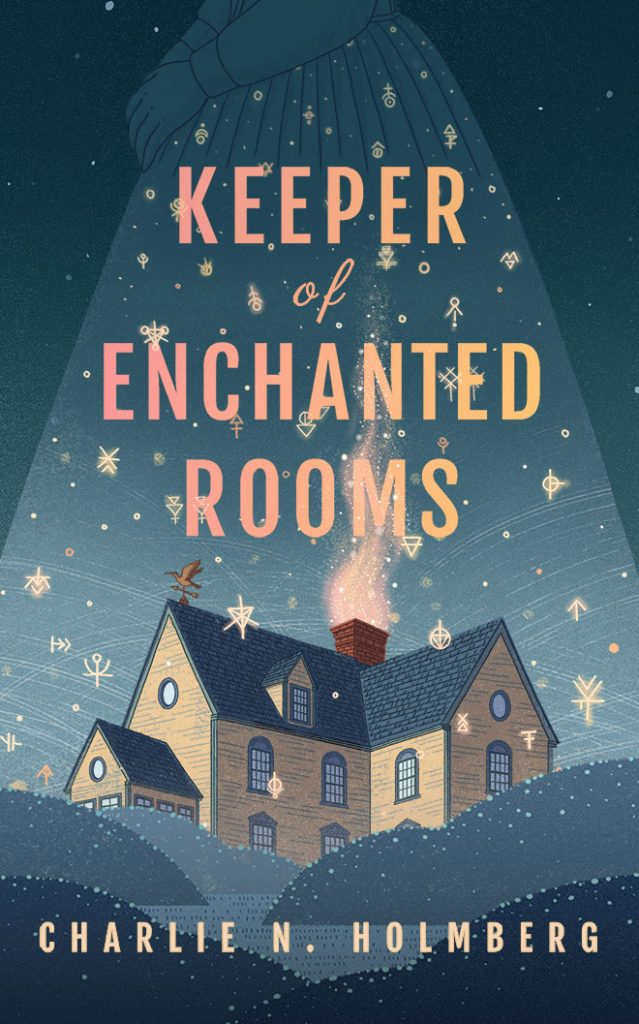Charlie N. Holmberg’s Keeper of Enchanted Rooms is funny, magical, and creates a fascinating universe to lose yourself in. I’m not saying that Keeper of Enchanted Rooms is a lifesaver, but I’m also not not saying that—during this particularly stressful finals season, Holmberg’s fun and lighthearted book was a much-needed escape from pages of dry, analytical papers. The premise—a magical house with a personality very much of its own—is creative and seems tailor-made to become adapted into an Amazon Prime Video original. At times, it seems that this may be too much the case, considering the formulaic plot, but sometimes all you need is a slow-but-steady love story with a few twists and an exciting fight scene at the end. Luckily, there is a breakout star in Keeper of Enchanted Rooms, and that was the enchanted house itself.

We follow Merritt Fernsby, a messy long-haired writer-type (you can tell Holmberg wrote Merritt to be a little dreamy), as he moves into Whimbrel House, an estate mysteriously given to him by his estranged family on an island off Narragansett Bay. Also, Whimbrel House is magical—this is the United States in the 1840s and magic, while more diluted in the US than in Europe, is fairly commonplace. Enter Hulda Larkin, a housekeeper trained by the Boston Institute for the Keeping of Enchanted Rooms (BIKER), whose job is to help Merritt manage his unruly house (did I mention that it won’t let him leave?). Hulda and Merritt don’t get along very well—the perfect setup for an “unlikely” romance. On the side, there’s also a murderous and power-hungry wizard named Silas Hogwood (perfect evil wizard name, if you ask me) who has learned how to suction magic out of others; he’s hell-bent on destroying Hulda, who crossed him in the past, and stealing Merritt’s magical house.
Holmberg successfully develops Meritt and Hulda into original and entertaining characters, but the true artistry lies in making Whimbrel House come to life—literally. Trapped within the walls of Whimbrel is the spirit of a twelve-year-old wizard named Owein, and as a result, the house also acts like a twelve-year-old boy. Rooms rearrange themselves randomly, the main staircase turns into a slide every now and then, a hallway drips red paint from the ceiling, the library throws books at whoever enters, and carpets and furniture like to liquefy or change colours depending on the house’s mood. Every scene featuring Owein in Keeper of Enchanted Rooms is enlivened through his humorously erratic behaviour; the love story between Merritt and Hulda, while sweet and entertaining, is made far better by Owein’s chaotic attempts to bring them closer (literally—he’s not above suddenly slanting the house a good ninety degrees so Hulda and Merritt fall on top of each other, or stealthily inching their chairs closer and closer). Sadly, the house loses some of its wonderful anthropomorphic qualities near the end of the story. While this proves useful for Holberg’s upcoming sequel, I was disappointed in the loss of such a creative and unique character.
Fortunately, Holmberg’s hilarious metaphors also work excellently to keep the tone of the book silly and light. Here is one of my favourites, showcasing the perfect combination of self-consciousness and wittiness in Holmberg’s writing:
Merritt’s idea solidified, sticking to him like a briar on his shirt, just uncomfortable enough to notice. He chewed his lips and tried to peel it off, only to find another briar beside it.
He’d always considered himself good with metaphors.
Another excellent one is when Merritt sneaks inside a room, and “The door didn’t slam shut behind him, but as he moved to the center of the room, it creaked on its hinges, easing shut with the practice of an experienced lover.” I won’t spoil all of Holmberg’s delightful comparisons, but suffice it to say that she excellently mirrors Merritt’s own famous writing style, as we later discover when Hulda reads some of his work.
Keeper of Enchanted Rooms is an excellent escape from the drudgery of winter, finals, or whatever else may be bringing you down. It’s got magic, humour, a cute love story, and a troublesome but lovable house spirit—all of which would combine into an excellent TV show or movie. The wild and remote Rhode Island scenery surrounding Whimbrel House, the house’s pranks and eccentricities, and the terrifying Silas Hogwood (with all his strange and forbidden magic) would all translate excellently on screen. Given that Holmberg’s publisher, 47North, is an Amazon company, I wouldn’t be surprised if we saw it streaming sometime soon.
